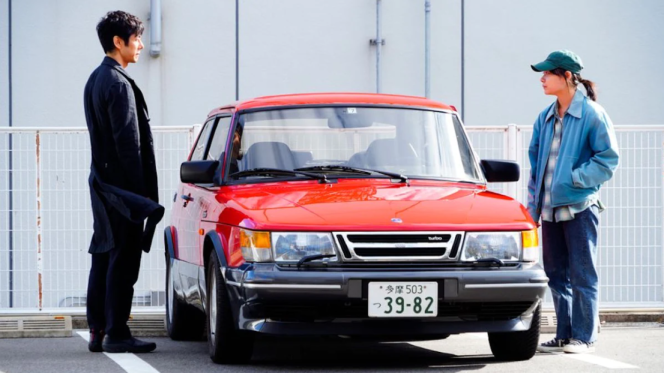Chekhov’s Car
Freshly out of Cannes with an award for Best Screenplay – and deservedly so – Ryûsuke Hamaguchi’s latest film, Drive My Car / Doraibu mai kâ is perhaps the best Haruki Murakami adaptation of all time (so far), contending maybe only with Lee Chang-dong’s equally enthralling Burning (2018). It must be said that this is not the only great film the director has put out this year, as his earlier-released Wheel of Fortune and Fantasy / Gûzen to sôzô is in its own right a compelling tale of modern life and love.
Based on Murakami’s short story of the same name, a piece of just a few dozen pages from his Men Without Women, Drive My Car also shares the same premise: an actor-director named Yûsuke Kafuku (Hidetoshi Nishijima), struggling with his wife Oto’s (Reika Kirishima) death, finds a confidante in his newly assigned young driver (Tôko Miura). While initially reluctant to let anyone else drive him, so as not to take away the intimacy of rehearsing his lines in the car, as they ride along to Oto’s recorded voice delivering lines from Chekhov’s Uncle Vanya, an old Saab becomes a space of intimate stories and of Kafuku’s meditation on his wife’s infidelities, as well as of innocent and melancholic comradeship in face of life’s bizarre ways.
Yet Hamaguchi adds much more to the story, expanding it into an intricate tableau of characters and sensibilities, and into a script of incredible precision and complex interactions. What in the original text was only a second-hand retelling of a sought-out friendship between the husband and one of his wife’s lovers, Takatsuki (Masaki Okada), in the film becomes a fascinating cat and mouse-like play between two men, one older and one much younger. Hamaguchi explores a certain ambivalence of them bonding – yet seemingly also punishing each other – through memories and admiration for a woman they both love. Kafuku casts Takatsuki as Vanya for a staging of Chekov’s play in a theatre in Hiroshima – a role much too demanding and for which Takatsuki is much too young, and equally a role Kafuku himself has played before. Is it revenge, is it the perverse feeling of knowing he is replacing himself with his wife’s lover or is it hope and mentorship, as Takatsuki proves to be a promising young actor? It could be all of them, so complex is Hamaguchi’s script and so nuanced is Nishijima’s acting. Their relationship culminates with perhaps one of the most beautiful moments in recent cinema between two men loving the same woman. Yet again under the same auspicious roof of the Saab, different tellings of a story are exchanged, a story they were both intimately told by Oto as they were having sex. The pretext of the Chekov’s play, thought out as a production in multiple foreign languages, also allows for an array of other actors to be added to the story, from which most memorable is mute actress Yoon-a (Park Yoo-rim). Soon enough, we find that lines from the text and rehearsals have become means of projecting what cannot be said between Hamaguchi’s characters themselves, in a bittersweet interrogation of where in our everyday lives the acting ends and the genuine begins.

To adapt Murakami in a satisfying way is essentially a very difficult thing to do and many have failed to live up to the task, as is the case with films such as Norwegian Wood (2011, Tran Anh Hung), which fell into the trap of over-romanticising and of pushing eroticism too much into deviance. But Hamaguchi seems to understand perfectly what’s so particular about Murakami and how to replicate it – dare I say, even to improve upon it, at times. We have a good amount of the author’s trademarks: a fascination and assimilation of Western art, Beethoven and jazz, vinyl players, whiskey in bars, bizzare stories, eroticism and casual sex, mysterious women disappearing mysteriously, and an idealistic and cultured male lead, always in some sort of lesser or bigger crisis. Nishijima is exactly what I’ve always pictured the ideal Murakami main character to look like. With a certain charisma pertaining to his age, he seems like the perfect embodiment of that very specific restrained sadness of an internally very romantic man that Murakami often employs. The driver’s well-balanced combination of temperance, calm and tomboyishness also seems to be a good fit for the character’s description in the original story; if anything, the presence that Miura employs in her acting makes the driver feel like a second main character, with a story of her own, and not relegated to a sole role of helping Kufuku work through his anxieties.
On the topic of casting, I’d also like to point out the character of Takatsuki. Here I think Hamaguchi makes a conscious and very self-referential gesture in choosing Okada to play the wife’s lover. What context he adds here is that, much like the character in the film, Okada himself is a young good-looking actor whose career started in Japanese TV dramas. I may be speculating too much, but in how Hamaguchi handles the character I think there lies a subtle commentary about Japan’s idol and “pretty face” actors, both in terms of how they might be disconnected from proper acting and art (as would be theatre) and of how there has been a decent number of them involved in career ruining scandals, as is suggested with Takatsuki.
Yet what primarily makes Drive My Car an exceptional Murakami adaptation is how the film uses language and dialogue. I think there is very often a very cinematic quality in how Haruki Murakami writes; he employs a very visual style and a romanticisation of the mundane that cinema seems perfect for. However, the author is equally extremely literary and uses many devices or situations that are easy to become irrelevant when adapted to the screen. He uses words for the sake of words, monologues, retellings of stories rather than the actual action in real time, transcripts, cassettes (as is here the case with Oto’s voice recordings), the beauty of which lies exactly in the fact that they are spoken or read, but never shown. Hamaguchi embraces these, weaving them into the main theme of the film and paying close attention to emotional qualities of the dialogues.
If the director’s previous films, such as Asako I & II (2018), while still retaining or being interested in literary qualities or structures, focused more on the theme of identity and relating, Drive My Car centres around the act of communication and storytelling. There exists an impossibility of direct communication channeled through lines of a play, there exists the mesmerising beauty of telling a story, as both Kafuku and Takatsuki seem to be enamored with the fleeting act of the woman they love sharing out loud where her newest inspirations. Chekov’s Vanya as performed by the actors, Oto’s stories after sex, told by herself and retold by others, and Oto’s readings of Vanya all in turn become subjects of the film, evoking in us quite deep feelings, while not showing us almost anything other than the words themselves. These are the film’s most compelling moments, where the director’s controlled aesthetic urges us to pay attention to what is being told, relying solely on the literary quality of the dialogue. The recurring story of the girl sneaking into a boy’s house feels, hence, like reading a Murakami text itself – in fact, it’s so similar in spirit it could actually be, I have yet to check.
Hamaguchi’s interest in the use of language in cinema also extends to the staging of the play and to how characters establish communication, as well as to how communication is at times met with crises. Chekhov’s play mostly happens in the form of rehearsals, where they read the dialogue more than they act it. Lines from Vanya take the place of real interaction, text becomes proxy. The relevant detail here is that the play happens in five languages at the same time, every actor performing in his own language and forced to react to the other actors by overcoming the barrier of communication. There stands out Yoon-a as a mute actress, as she acts in sign language. What Yoon-a shows is that this barrier can be overcome, that language and communication take many and different forms, equally valid, that don’t necessarily limit themselves to words. There are things which words escape.

Finally, as the play progresses, the constant change between languages feels more and more natural. Hamaguchi excels in Drive My Car in finding the natural. Despite what seem like unlikely coincidences, everything falls into place, nothing is forced. There is no excessive romanticisation. Yusuke’s glaucoma and Yoon-a’s muteness are mere details of life and never dwelled upon as anything other than natural parts of life; there’s no gaze of disability, no tear-jerking exploitation, despite Yoon-a’s acting through sign language being a central aspect of the play. This subtle form of inclusion also extends to how other nationalities and languages are treated in the film. Chekov’s Vanya in five languages corresponds to a modern art world seen as inclusive and hopeful, where everyone can have a place and interact with each other as if no difference, national or otherwise, exists. Art and its language, just like Chekov, prove to be universal.
This obviously operates very well with the between-the-lines multiculturalism that Murakami’s writing also shares – a universe of the modern man where the East and the West influence each other and converge into the same melting pot of popular culture, and where good art comes from anywhere. But it also made me think of something Nagisa Oshima once said in the 90s about the future of Japanese cinema. At the time, he seemed very happy with a few films which made use of ethnically Korean actors, and remarked that the future of Japanese cinema can only happen if it embraces actors and themes of other (neighbouring) nationalities and ethnicities. Ryûsuke Hamaguchi does embrace these other nationalities, as the film has a good number of non-Japanese Asian actors (and characters), yet his most recent films also make him one of the brightest rays of hope in the upcoming future of cinema.
That being said, Drive My Car is a soulful tale of modern life, closely vibrating with that same serene melancholy of Haruki Murakami’s writing – a beautiful dance between what lies behind words and what words themselves can say, where acting and real life bond into the same sensuous fiber.
Title
Drive my car
Director/ Screenwriter
Ryûsuke Hamaguchi
Actors
]Hidetoshi Nishijima, Sonia Yuan
Country
Japan
Year
2021

Graduated with a BA in film directing and a MA in film studies from UNATC; she's also studied history of art. Also collaborates with the Acoperisul de Sticla film magazine and is a former coordinator of FILM MENU. She's dedicated herself to '60-'70s Japanese cinema and Irish post-punk music bands. Still keeps a picture of Leslie Cheung in her wallet.


